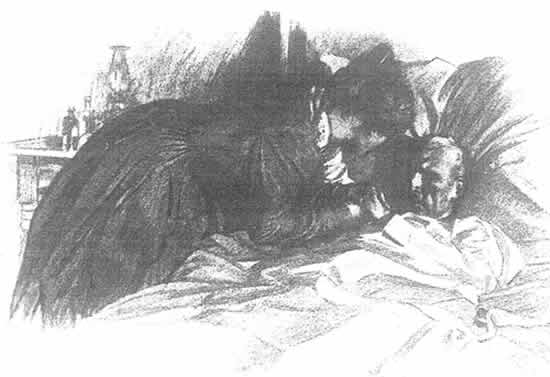

Tell 'em, Plutonians.
16
Lady Bertram, due to (in Austen's words) ill health and indolence, gives up the house in London—this allows the action to be kept simple and intimate so Fanny can always stay at Mansfield Park and not take journeys to London. This is how Austen uses her characterization as part of Structure. Lady Bertram has already been established as a haughty woman, so a tendency towards convenient ill health to get her way is in keeping with her character. But…it does more than give Austen her excuse to focus the story on Mansfield Park. It also allows Mrs. Norris and her views to firmly hold sway over both the Bertram education and the entire household during Sir Thomas's journey to the Lesser Antilles. A languid woman like Lady Bertram holds little chance against the shrewish dynamo of her sister.
17
The living at Mansfield Park's parsonage is crucial to the story. Under English tradition and law, clergymen were not only immune from taxes but actually lived on parish tithing. Sir Thomas wants to give the Mansfield Park living to serious, studious, honorable Edmund, who is not yet ready to be ordained when Reverend Norris dies. Most noblemen in this situation would offer the living to a friend to hold for a few years at no profit to themselves…but Tom's debts have made this unfeasible for Sir Thomas, who must award the living to Dr. Grant in exchange for rent. Structure again, as Nabokov carefully explains all of this so on the following page, his students will get the point: Norris's death and Tom's wasteful nature bring about the coming of the Grants…who will in turn bring the Crawfords…and thus the entire plot of the novel can move forward. A contrast is also drawn between Tom and Edmund. Edmund, as mentioned, is the true inheritor of Sir Thomas's grand, overbearing, serious, but ultimately good demeanor…their similarities become more pronounced after Sir Thomas's return and he reveals the same warm, caring spirit Edmund holds throughout the novel. Tom speaks in "slang," a far cry from their ultra-formal speechifying, and seems to care for nothing, particularly his family.
18
Austen removes Sir Thomas from Mansfield Park so the main characters can "overindulge their freedom," then brings him back just at the "mild orgy" provoked by the play. Sir Thomas leaves for the Lesser Antilles again because of Tom's indebtedness, wanting to secure the Bertram fortune. The Prodigal Son (and Tom is a prodigal, returning to good sense at novel's end) is a cliché, but it is an appropriate one for a story with a clergyman hero, a highly moral sensibility, and plenty of religious overtones (Couldn't we say that Edmund and Tom are Cain and Abel in some ways?). So not only is Austen justified in using a hackworn device, she can be commended by using it as the impetus for major action in the novel.
Antigua is a far cry from Northampton. That it is, but once in a while I come across sentences in Nabokov so delightful I want to share them. One of the marks of a great teacher is being able to use honest humor in appropriate manners to win your students over. Nabokov's wit, so evident in Lolita, is just as present in these lectures.
19
The deaths of Mr. Norris and Fanny's pony are "functional because both deaths…are introduced for structural purposes, purposes of development." Nabokov, in his written notes, draws a contrast between Jane Austen's "dull deaths…which happen behind the scenes and excite little emotion" to the dramatic, grand, emotional deaths in Dickens's works, Madame Bovary, and Anna Karenina. Austen is certainly a dramatic writer, but she does not wring drama from last sighs and mortal declarations…such drama contrasts with the orderly worlds of her comedies of manners. Her drama comes from people figuring out how to merge their identities with the norms and codes of society. It is a drama focused on the living, not the dead. Remember, Northanger Abbey may be her most satirical of satires.
However, Austen uses death to facilitate her drama, as Nabokov admits when calling their influence "curiously strong." There are five deaths altogether in Mansfield Park:
- Reverend Norris, whose passing brings the Grants, and then the Crawfords.
- Fanny's pony, replaced by a new horse which a smitten Edmund persuades her to lend to Mary, whose domineering time with it will cause levels of quiet pain for Fanny and provide the first emotional upheaval for this central trio.
- The grandmother of John Yates's friend. This death is so dull it happens far from the action…but it may be the most important death in the novel apart from Norris's, for it brings a frustrated John Yates to Mansfield Park, ready and eager to instigate a very inappropriate form of entertainment.
- Mary Price, who dies years and years before she is even properly mentioned, but whose silver knife is the catalyst for the dramatic centerpiece of the Portsmouth sequence.
- Dr. Grant. The first four deaths in Mansfield Park all result in psychological tempests for the characters and negative action in the story. Death is destructive. However, when Dr. Grant—a character who comes into the story BECAUSE of the first death—becomes the last death, it allows Edmund and Fanny to take possession of the Mansfield Park living at last. The death of a result of death brings goodness. Indeed, it brings life, for Austen's language in the scene, Nabokov says, tells the reader that the happy couple are expecting their first child. For death to bring a presence whose own departure heralds new life is Structure supreme and excellent drama.
20
The Sotherton escapade and Austen's "successful schemes" link together. One of the running Themes in the novel is the idea of improvement, of scheming to become happy and make your situation better than it already is. Except for Fanny, everyone in Mansfield Park has a scheme—even Edmund hopes to romance Mary. However, her artlessness and his nobility contrast to Mr. Rushworth's buffoonish talk of "improving" Sotherton to the matrimonial schemes of all the other female characters, especially Mrs. Norris and Mrs. Rushworth in their plotting. When every person on the scene has a scheme, such schemes naturally collide and merge into an uber-scheme, and so Mary's newfound love of riding and desire to keep seeing things in company with Edmund and the other Bertrams, to find "another shady lane," leads them all to the shady lanes of Sotherton and one of the most important sequences in the novel.
No comments:
Post a Comment